Last Updated on February 4, 2024 by Matt Greene
Have you ever sniffed the aroma of a sub 80 score, only to have it snatched from you with a closing double bogey?
It's enough to make a grown man cry.
But you're about to find out how to break 80 in golf in the simplest, most deconstructed guide you'll ever read. I've included videos of my friends actually breaking 80, shot by shot just to show you that I say what I do and do what I say. You can see it on my Youtube channel, Golf Sidekick.
You won't be changing your swing either. The swing you have got you here, so it's good enough to get you to break 80. You've always known how to break 80, but it's time to take action and get that break 80 feeling!
Some tips will feel like instant fixes (that actually work) while others require brain power and discipline to implement.
But once you do, you're breaking 80 within 10 rounds.
How to Break 80 in Golf Consistently
Some guides tell you that 79 is just 11 pars and 7 bogeys in an attempt to tell you how to break 80 in golf.
That's retarded.
Our brains are masters of deception and the 7 bogey-11 par theory hides itself as a dangerous demon of deception.

There is a far simpler, faster, easier way to break 80 without getting stressed about double bogeys wrecking your card.
My system even embraces a double or triple bogey.
The Golf Sidekick Triple 6 Breaking 80 System
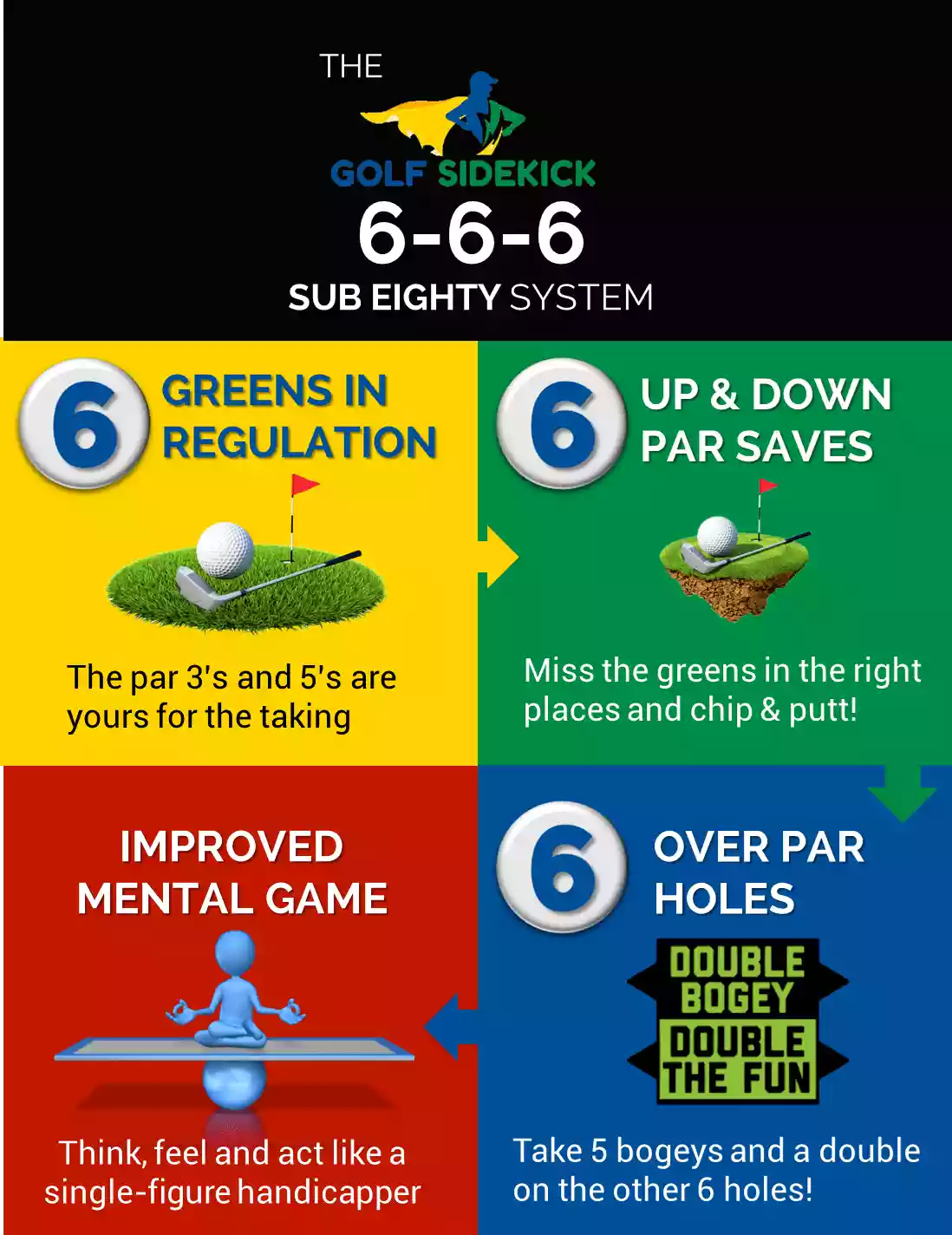
You need to hit 3 mediocre stats to break 80
- Hit SIX greens in regulation.
- Get up and down SIX times to save par.
- Try to reduce the big numbers on the other SIX holes you may screw up.
The six holes in number 3 above, we call your ‘birthday’ holes to allow yourself some screw ups. You will make double bogeys there is no avoiding it.
The most important thing you must remember: you allow yourself room for error to avoid becoming despondent if you have a bad hole. The focus here is on the process of hitting smart shots so you don't blow up with triple bogey or more.
So what skills do we need to accomplish breaking 80 with the 6-6-6 method? Check it out below.
Breaking 80 Course Management
Miss approach shots in the right places
Golf is a game of missing.
Golf is a game of errors as we all miss more shots than we make.
The guys who score the best, miss their shots in the best areas without much penalty.
Every course designer provides golfers with a ‘bail-out’ area and it’s your job as a smart golfer to find these areas and use them as the designer intended.
Often, by not scoping the surrounds of the green on your approach shots, you don’t plan for where your ball might miss the target and because you're so hell-bent on pin-hunting, you miss the green in the worst position, short-siding yourself with an impossible chip.
We want to avoid certain situations:
- Chipping onto a downslope
- Bunker shots toward water
- Chipping onto elevated greens from the valley below
- Pitching to flags tucked on the edge of the green we are closest to
Ideally, we want:
- Lots of green to work with
- Chips and pitches onto an upslope or flat surface
High Percentage Planning & Aiming
We stated the goal is to hit SIX greens in regulation.
You can hit six out of eighteen greens at your skill level. If you do not believe that, then you should start believing it.
But to increase your chances, we want to aim at the correct part of the green.
By doing this, we increase our number of birdie and par chances and decrease the chance of making double and triple bogeys.
Plan from the green backwards
From my experience, the best rounds I’ve played have been the ones I plan best for.
A great strategy is to plan the hole from the green back to the tee.
Let’s look at some examples.

Think about what club you want into the green and then work your way back from there. If you can't hit the green in two shots, say to yourself on the tee: 'ok self, I want to hit a nice smooth PW 100 yards into the green. I have 360 yards to go before that. I'll hit a 3 wood 210 yards and then a 6 iron 150 to set up my PW.'
- Can you hit this 460 yard par 5 in two?
- Are you comfortable with a driver in your hands?
- How have you been hitting the driver today?
- What's your go-to club off the tee?
- Will your shot shape go toward a water hazard?
Let's play the safest option with the best return on our investment.
If I'm hitting the driver well, I will go for this one in two shots all day but that doesn't necessarily mean I need to hit driver.
If I hit my 4 wood, I can reach the green with a 3 iron on my second shot.
If I have no confidence with either of my woods, a hybrid off the tee can leave me another hybrid to the green or I might break the approach shot into an 8 iron and a gap wedge.
Plan to your strengths on approaches and you'll see more birdies and less scores over par on the par 5's.
The par 4 planning

On any hole less than 410 yards, I spend a lot more time thinking about my tee shot.
410+ is an easy decision to reach for the driver but holes between 300 and 400 yards are tricky.
We would do well to think ahead here.
- Do we want a 100 yard shot into the green with more chance of hitting into hazards off the tee?
- Do we want a PW from 125 into the green with a medium amount of risk off the tee or a 150 yarder into the green, hitting our tee shot to the fattest part of the fairway?
Hit the club that avoids the dangers off the tee, but leaves you a comfortable shot into the green.
- Which club consistently shapes the right way for the direction of the hole?
- Which irons are you very happy to hit into the greens?
Mine are 53°, PW, 7 iron and 6 iron. If I can hit my tee shot to any of those clubs distances, I am a very happy boy.
On par 4's, I might hit anything from a 6 iron to a 4 iron to a 4 wood off the tee.
Whatever gets me in the best position for my approach! Forget what others think and play your game which often should include shorter clubs off the tee!
Aim to the fattest part
Flag hunting is usually what gets us in trouble and stops us breaking 80.
Those pins tucked behind bunkers and next to steep run-offs are so tempting to shoot at but I bet if we took two guys: one who hits it at every pin over 18 holes and one who hits it at the heart of the green regardless of pin-location, the pin-hunter would lose badly.
Aiming to the middle of the green on most holes is more advisable. Beyond that, it’s even better if you aim at the part of the green where your normal shot shape will shape toward the target but if you hit a dead straight shot, you'll be in a safe position either on the green or facing an easy chip.
Examples of aiming for a miss
In the image below, you can see how much space exists on the green over the bunker. You have 12 to 18 feet of green beyond the bunker until you hit the back edge.
If you take the bunker completely out of play and hit the ball left of the bunker, you have 30-40 feet of space to land the ball without going over the back of the green. Think smart.
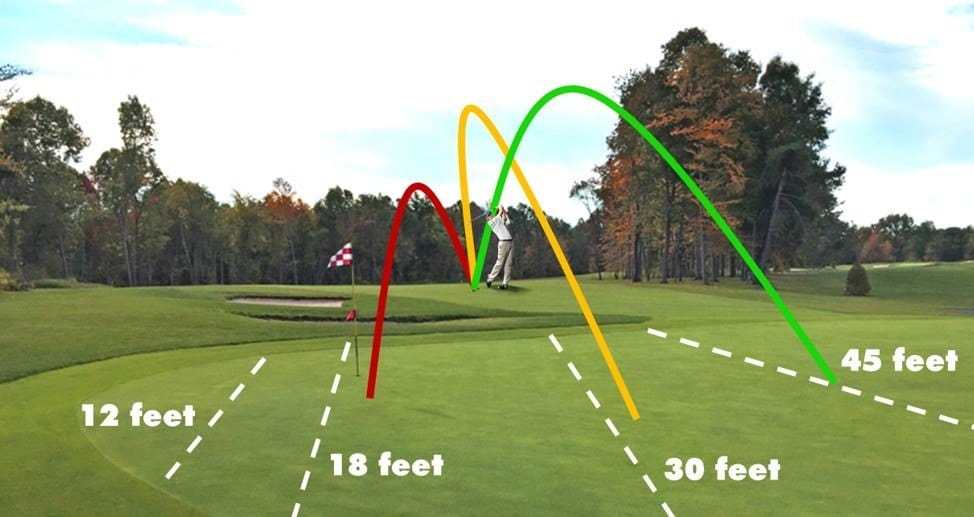
Going for sucker pins tucked behind bunkers is for the pros. The closer you get to the edge of the green, the more precise you need to be. Flying it over a bunker from 150 yards means you have far less green to land the ball on and hold the green. Aiming for the heart of the green gives you MUCH more space to hold a green and have a putt for birdie or par.
What's one of the worst habits we make as amateurs? We often plan for that 1 in 20 shot that goes 10 yards further than our average and we often leave the approach shots short in the bunkers or deep-grass valleys, short-siding ourselves. Getting up and down from here is extremely difficult. For lower scores, aim away from the pin and danger and use enough club to carry the trouble..
Use enough club
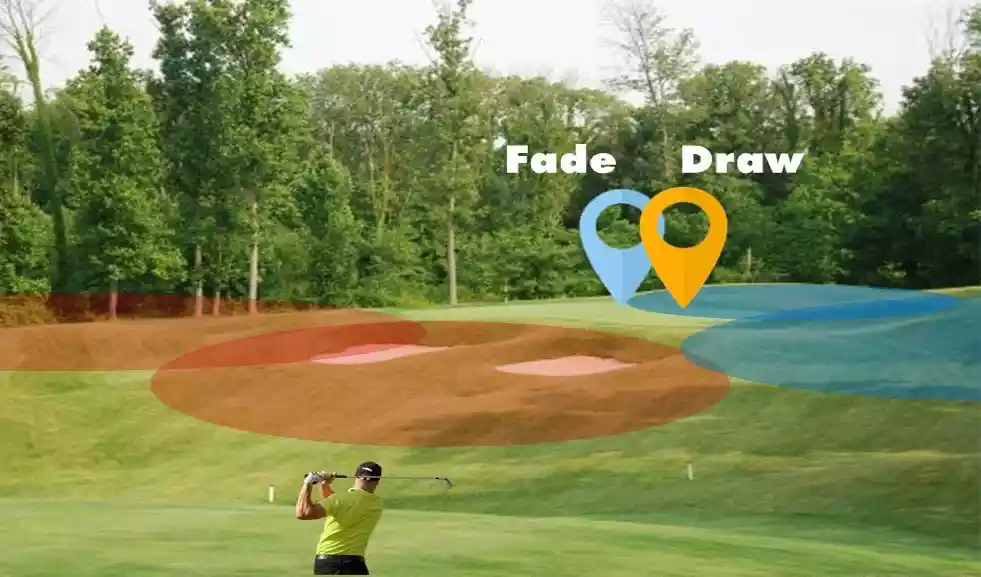
Use enough club to avoid the front side hazards and realize that there are bail out areas.
Find the one place you want to avoid and take measures to avoid it. Find the one place you will be safe and hit it there!
Careful of the sucker pin
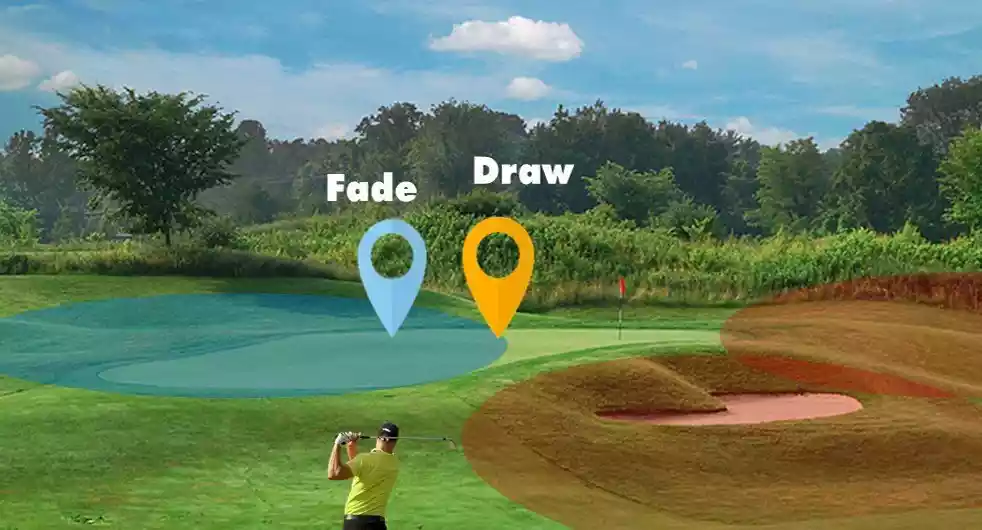
The ultimate sucker pin. Notice how much green there is to the left of the pin?
Right and short of the pin, NOT SO MUCH!
You can miss the entire green on the left side and still have an easy chip. Short and right and you're in a world of pain.
Sometimes short is the play!
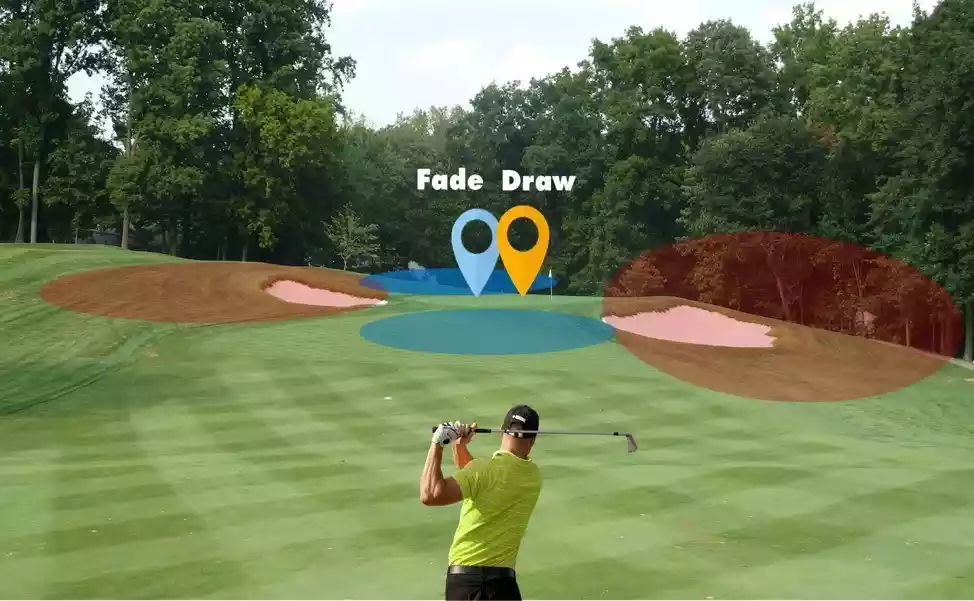
Sometimes the hazards are in line with the green.
Look for where the safe zones are. Usually short or long will be safe and in the picture above I would rather be short or long than right or left. I'd take one club extra and make sure I swing easy to avoid errant shots left or right.
As you can see, slope makes a huge difference.
We don't want to be chipping over a bunker toward another bunker or hitting a bunker shot toward another bunker. Aim to the mid-point of the two bunkers and allow your shot shape to take over. Take one more club to make sure you get past the bunkers.
Where are the bail out areas?

Often the bail-out areas have been made obvious by the designer.
They normally leave a wide, flat fairway to one side of the hole or both. In the picture above, it's short right and left but long here is a no-no.
Take advantage of the designers intentions. Unless it's a particularly mean designer, there should always be an area to hit to that will leave a relatively easy chip if you miscue the shot.
Where's the biggest landing area?

Sometimes we get so target-fixated that we don't even see how much green there is. Shooting at the pin above brings a chance of hitting it left in the valley or over into the bunker, leaving us a downhill bunker shot.
Adjusting the line just to the right of the pin means we open up a highway width part of the green. You might have a long 30 foot putt, but it's definitely better than a 30 foot bunker shot onto a down slope or a chip up hill onto a down slope.

Know your distances as precisely as possible
This is of such extreme importance, it should be the first thing golfers are taught after they learn to hit a golf ball.
I never thought I needed a rangefinder or GPS golf device until I got one and I wondered why I struggled so long without it!
For this section, a distance measuring device is non-negotiable. I personally use a Voicecaddie L6 rangefinder to tell me distances to obstacles, hazards and pins.
I pair that with the ShotScope H4 to measure and track my distances with each club. You can do this with a GPS golf watch too but I use my H4 because I keep it in my pocket and don't like wearing watches.
That means that when you have a rangefinder to tell you the precise distances to pins and hazards, you have a perfectly accurate measurement to match to the distance you already stored for each club! You'll be filled with confidence and commitment once you know your game this intimately.
This is my single favorite tip in this whole guide and a rangefinder or GPS device are the best investments you’ll ever make in your game!
Have a go-to shot
At different times, some part of our game can just suddenly switch off. It’s usually the long game for me.
So how do we fix this while we’re on the course and things are looking bad off the tee, around the greens or on approaches?
We develop one shot that we know we can fall back on at any moment under pressure or whenever.
We all have our favorite clubs in our bag and this should be your starting point.
Work on those clubs at the range and on the course to feel like you can whip them out any time and pull off great shots when you're on the verge of mental breakdown.
My personal go-to shots are:
- PW with my feet almost touching in my stance, swinging at 75%. This shot reliably goes 100-110 yards at the target for when I need a clutch save. I developed it by accident doing the feet together drill on the driving range to fix my balance!
- 17° 4-wood off the tee. I can rocket this thing 240-260 yards and trust it will be on the fairway for when my driver goes wonky. I’ve always liked the club and it just became my favorite club immediately.
- 6 iron from 185 - 195 yards. I have so much confidence with this club for no reason. I whip it out and know even if I missed the last 5 greens with wedges, I can hit the green with the 6. I often hit tee shots to 185 yards to hit my 6 iron in.
- PW for chipping as often as I can because I practiced with it so much on the chipping green. I've practiced it from different lies, distances, locations in my stance, everything.
The club and style of shot you choose depends on your preferences and feelings. Play around on the range and have fun. You might discover a little secret that you can use on the course. Do it your way and forget what the gurus tell you in Golf Digest.
Keep detailed statistics of your rounds
Recording your statistics is essential to analyze where you’re deficient and where you excel. Using your score card is the easiest way to keep track of how you played. Vital information I like to track is:
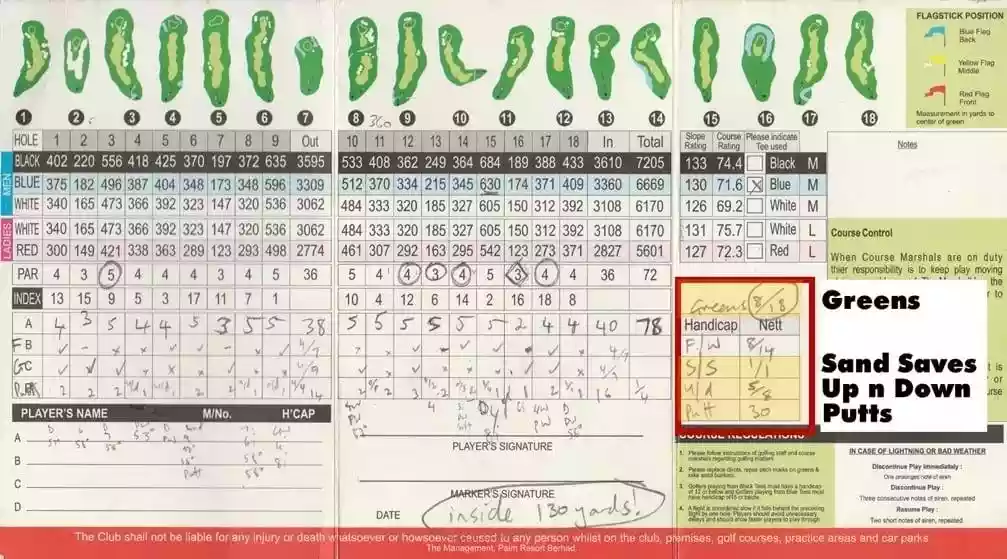
- Fairways
- Greens in regulation
- Scrambling up and down
- Sand saves
- Number of putts
Afterward, we can look at a poor statistic and ask why it happened and then take corrective action through practice.
You can keep track of this all in the GolfShot app mentioned above..
The Mental Game

Discipline yourself to stick to the gameplan
It’s so easy to have a bad hole and throw the round away only to regret it after a few holes.
Breaking 80 is about discipline - whether sticking to hitting at the heart of the green, hitting irons off the tee, practicing your short game or splitting a 300 yard shot into two full shots - we need to stay on the path to greatness.
Put ego aside and play YOUR game
I play golf occasionally with an 18 year old kid who hits a 4-iron 240 yards, all carry. He hits a 9 iron from 165! Sometimes I succumb and try keep up with him and bomb every drive and take one less club on approaches.
You know what happens? I hit balls in the water; OB; top them; teeth them...all because I forget that I can still beat him hitting it shorter than him. Around the greens I'm much better than him! But the damage is done by the time I get to the green.
We need to eliminate the silly errors from tee to green to give us a chance at par on every hole.
So another top tip is, PLAY YOUR OWN GAME regardless of anyone else. Don’t change club selections to impress anyone. Don’t be silly like me and hit a 9 iron from 160 when it only goes 148...just to show a youngster I can keep up!
Remove negative language and negative thinking

Use positive talk and avoid getting depressed because the results are not what you expected. Sometimes we make good swings or putts but we just didn’t calculate winds or lines correctly.
Instead of throwing the club into the lake after your shot lands in the bunker short, assess the reason why it happened.
We can be unhappy with the stroke but take corrective action immediately instead of letting our emotions take over. Did you pick the wrong club because of ego? Did you pull out of the shot because you thought you had too much club? Whatever the reason, take note of it and try to improve on the next shot. If it was a good shot, there is no reason to get upset.
See the missed green as an opportunity to show off your short game skills. After you top your drive, remember all those times you parred a hole after topping the drive. Replace thoughts like "oh here comes a bogey" with thoughts like "it just takes one good shot to save the hole".
Every poor shot is a learning experience for the rest of the round. There is one major reason for those bad shots at this level of golf though:
Lack of commitment
Commitment to every single shot is vital

Having a plan for every shot and envisioning it in your mind is key to committing to shots and getting the result you desire. Making the correct club selection through knowing your distances and shot shape are the lifeblood fueling your goal of breaking 80. Doubting yourself destroys all the best-laid plans.
Our brains are so good at subconsciously talking us out of doing something or planting little seeds of doubt in our heads. Like when you’re on the tee and your brain says 'you don’t have enough to clear that bunker'. You then hit it in the bunker or top it because at the top of your backswing, your brain made your body tense up and autocorrect to match the actions dreamed up in your head.
You have a 7 iron into the green but you pull an 8 and stand over the ball thinking this isn’t enough club. Or when you’re standing on a divot on the tee box and all you’re thinking is, I should tee up somewhere else. But you don’t and mess up the shot!
How about when there’s out of bounds left, you’ve been hitting a fade all week and at the top of this back swing, your little lizard brain says “don’t hit it left”. With a solid commitment and focus on the positive language to describe your action, you’ll notice these top-of-backswing thoughts disappear.
We never seem to be able to reset and regain commitment to a shot when anything distracts us. We need no distractions and only full concentration and commitment to the shot ahead - flight path, club choice, distance and shape.
Positive internal monologue

Here's the classic example. Don't think of an elephant! Are you thinking of an elephant? It's the same with golf. Don't hit it in the water! Are you thinking about a small lake now? That's where your brain wants the ball to go!
Use positive language when you’re planning and visualizing the shot in your mind before you hit it. You’re standing behind the ball imagining the flight path, where it lands and with what shape it’s going to take. Only hit that ball once your mind can see only that.
When there are hazards, avoid talking to yourself like this: “Don’t go left you idiot - you’re the kind of person who hits a fade but hooks it on the one hole with water left.” Say something like this: “I’ll start this one out over the center of the fairway and my baby fade will push it toward the right side.” Can you feel the difference? One statement starts with a negative "don't" and the other focuses on taking the positive action instead of avoiding something bad.
Honestly, this tip has made a HUGE difference to my game. I was the quintessential negative-talk specialist and my round could spiral out of control after the first missed green with a pitching wedge. When you feel the negative talking devil on your shoulder, start speaking in positives and remove the word "DON'T" and "CAN'T" from your vocabulary.
Emotional control
Hitting 135 yards into a par 4 for your second shot is a dream, but sometimes you miscue a shot and you make a double bogey out of nowhere.
Oh no! That’s when we go full John Daly and lose our minds.
The main point of the 6-6-6 method is to get you working on a process instead of hitting pure KPI's.
Our pursuit of better golf is the goal and by focusing on each shot, the actual result of the hole means nothing to us.
We look only at the shot in front of us as the most important so we can set ourselves up for the next shot. Never, ever, never, never hit a throw-away shot. You know when you duff your hybrid into the par 4 for your second shot? Under no circumstances are we allowed to rush the next shot because we’re angry. Reset and do better.
Go through your full routine and slow down. Consciously slow yourself down after a bad shot and make the next one the best shot you’ve ever hit because it might be the one that stops 3 feet from the pin and you jam an amazing par!
We really want to keep doubles and triples off the cards and one of the ways to do that is to remain in control of our emotions to make better decisions even after the worst of shots. There are so many other things to get genuinely upset over but a stray golf shot is actually a privilege. We're on the course, away from the nagging women and we're not in an office but on a beautiful golf course!
Relax - life could be worse.
Next Stop: Skill Building
Okay, so we can hit the greens through planning and execution with total commitment.
We can hit the ball to the heart of the greens and we know our distances, shot shapes and temperament.
We've done 80% of the battle right there.
But in the 6-6-6 system, we MISS up to twelve greens! So how do we get up and down 6 of those times to save a par to allow us some freedom to screw up?
Short game short game short game
Guys, there is no way around this one. The only difference between breaking 80 and shooting 85+ is getting up and down 50-60% of the time compared to hardly ever. So of the 12 greens we miss, we need to get up and down 6 or 7 times.
Luckily I LOVE the short game and I have a treat for you below. I hope some of my passion travels through my words on your screen, into your fingers, down your hands, stored to be transferred later to the club head.
Let’s get more in-depth...
Chip like a BAUS
This is the least glamorous part of golf so most people ignore it. To me, the finesse of a chip shot oozes just as much masculinity as a long bomb drive. I am in Nirvana when I’m chipping and when my putting goes south, I miss greens on purpose to chip instead!
How do we become a chipping boss? Practice.
Top tip: Choose one club you’re going to chip with the majority of the time and practice that at the chipping area a lot. By a lot, I mean twice a week, one or two hours a time. I would advise against a LW because it’s so much harder to predict the spin on lobby shots. I love the PW for my chipping.
Top tip: Don’t focus on the hole when chipping. Focus on the line like you would on a putt but then select a SPOT along that line to LAND the ball on. Be specific - like the size of a small coin in your country. Focus all your practice strokes on creating the stroke to get the ball to land on that spot and let the Golfing Gods take over the rest.
Top tip: Move the ball around in your stance and get a feel for it all. With my selected PW I can hit higher shots or lower skidders depending on the position of the ball in my stance.
Top tip: Once you become great at that one club, you’ll find when you’re in a position where you can’t use the PW because of slick greens, no green between you and the pin or chipping onto a downslope, you can just switch out to a higher loft (56° or 60°) and use the same technique with the same type of swing!
Top tip: If you have hard and dry fairways and rough at your course, get wedges with low bounce. This will help to stop the club bouncing off the surface and blading the chips. If you have moist, soft and fluffy fairways, you want wedges with bigger bounce and a chunky sole to get through the turf. Low bounce clubs will dig into soft ground.
Drain all your putts inside 5 feet and no three putts
Once you learn to chip like a boss, you need to convert those chips to pars. We’re going to aim to chip within two feet of the hole but sometimes we miss the line or overcook it. That’s where the ability to jam 5 footers all day will really cut strokes off your score.
Here’s how I learnt to putt and also how I practice putting.
To drill it or die it in?
There are two options for short putting.
1. Hit them hard and take the break out - I used to do this on bent grass growing up but since moving to Asia, I've needed to learn to putt on bermuda and other tropical grasses. With all that grain and how much it influences the putt, I use this technique only on uphill or flat putts AGAINST the grain.
2. Hit it soft and use the entire hole to your advantage - I've started using this technique and it works. Generally you're not going to be far off on your reads of short putts but with the wrong pace, it can leave you a 5 footer coming back if you hit it through the break.
What I now do is read the green, but then add a little more borrow and hit it just hard enough to get it to drop into the hole (not slam the back of the cup). By doing this, it moves the entrance of the hole to whichever side the break is coming from and relies less on lip-ins like slamming the ball hard.
It also increases the size of the hole by giving your ball the opportunity to dribble in even if you've over or under borrowed a bit because it's moving slower so it can lip in not out!
Extremely Key Concept
Nothing helps your putting if you don't have commitment. I played a golf holiday in Hua Hin Thailand in June 2018 and discovered you really need to just put your trust in the golf course, the grass, the grain and the universe. In fact, before I putt now, I'm telling myself "put it out there trust the universe"!
I know it sounds crazy but I've been draining way more of the tough 4 to 8 footers where I would usually under borrow and miss on the low side just by telling myself to trust the read and PUT IT OUT THERE.
Get out of bunkers like a soldier
Players of all levels seem to be allergic to bunker sand when they’re outside the bunker but never want to leave them when they’re inside them.
I love bunkers whether fairway or greenside. Below are a couple videos I prepared for you to learn how to get out of these hazards so you can shave a few strokes off your game.
Quick and Easy Tips to Break 80
Get custom-fit shafts
Nothing is as important in your clubs as the correct shafts and if your swing is poorly suited to the shaft you have, you're going to have a tough time finding fairways and hitting more greens. I used regular shafts for years until a friend told me I needed stiff, maybe X-stiff shafts.
I went to the pro, he fit my driver with a 72g X-Stiff shaft and my irons with stiff shafts. I dropped from a 7 handicap down to a 1 within 6 months and won 8 Saturday competitions in a row after that!
Make the investment, visit a reputable club-fitter near you and reap the benefits of having clubs that you can no longer complain about. The toughest part will be knowing you are the only one screwing up the shots and not your equipment!
Draw a stripe on a coin and your golf balls
For years I rejected this idea. Until I tried it for the first time...in 2016! I'm draining way more putts and feel better off the tee that my club face is aiming in the right direction. This alone will shave 2 shots off your game on the greens if you aren't doing it yet.
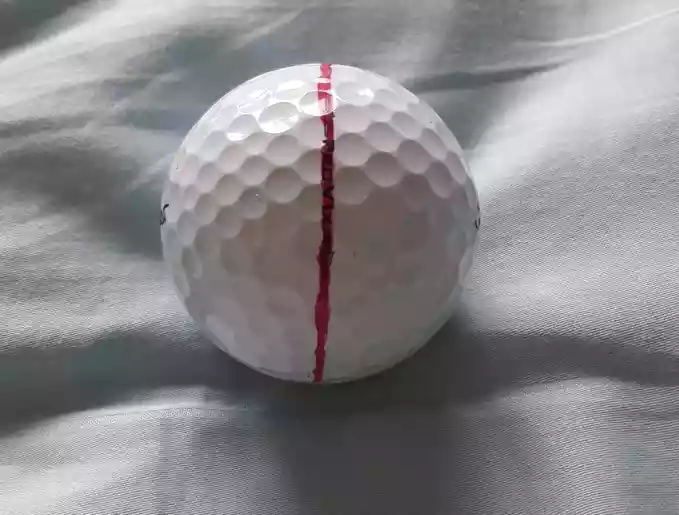
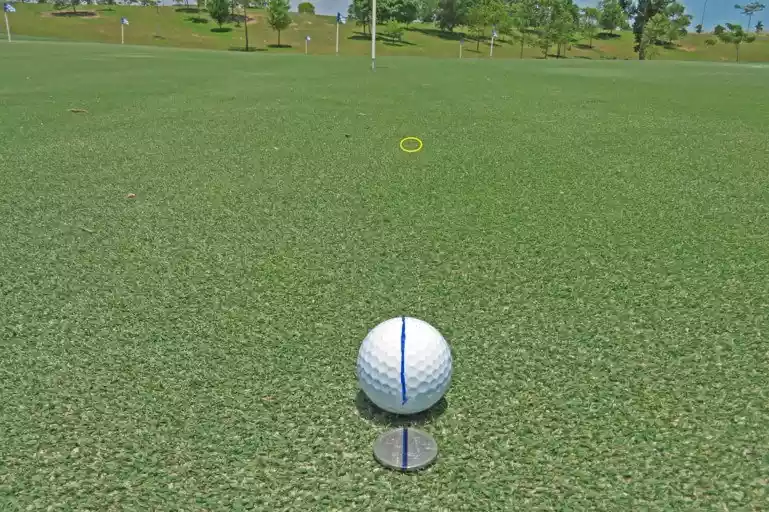
Use a striped coin to double your efforts on the greens
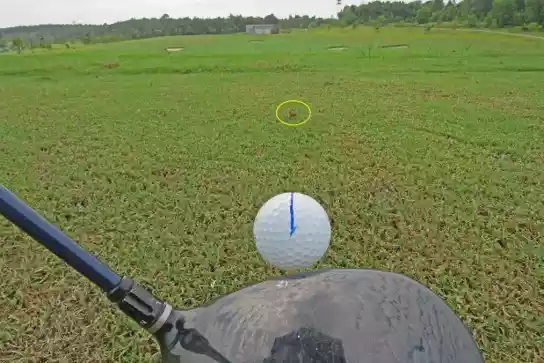
It takes a while to get used to aligning the line accurately but pays off quickly. You'll take about one full round to master the technique and after that it's plain sailing.
Draw a straight long stripe on your golf ball to help you aim the ball toward the target off the tee and on the green!
How does a line on the ball for alignment work?
When you tee the ball up, align the stripe down the fairway. On your putts, align the stripe to the line of your putt. Then line up your putter's alignment line with the stripe on the ball. Works like a charm! Now all you need to worry about on putts is the distance control.
Is an alignment aid in golf legal?
Yes. The pros use this same technique and you'll often see in close up shots, their ball rolling on putts with a line down the middle. Important: don't take too long aligning the ball to the hole on greens. Don't slow down pace of play.
What you need to add an alignment line to your ball
SoftSpikes make a stencil you can clip on the ball so you can draw your lines dead straight with a colored Sharpie of your choice.
Select the correct tees

You probably could've broken 80 already if you played off the correct tees!
How do you know which ones to pick? There are a couple of ways to select your tee box:
Select the correct tees based on your drive distance
Average drive distance multiplied by 28. So if your average drive is 230 yards, a challenging length of a course should be 230 yards x 28 = 6440 yards maximum.
You can go 5% higher or lower. So a range of between 6000 to 6700 yards. You won't be able to match the yardage to a set of tees exactly, but close enough!
Select the correct tees based on length of par 4's
If there are too many par fours over 400 yards on the course you play, move up a tee.
What if everyone else is playing off longer tees?
Fuhgeddaboudit! Hey man, stay strong, it's your game and you're there to have the most fun. No one minds if you play off shorter tees during social rounds! If you're in a good mood because you're enjoying your game and that makes it more fun for the other guys, they really don't care. But if you're playing poorly and getting in a bad mood off the longer tees, then it'll make it more unpleasant for them
Play with better players

We all have our best golfing buddies and some of us are lucky to have good players as buddies. But often we get stuck playing every round with guys who aren't interested in progressing.
If your golfing partners are not as good as you, I suggest finding a group to play with sometimes where you're the worst player in the group. It doesn't have to be a huge difference in skill level but at least guys who shoot less than 80 most of the time (sub-8 handicappers)
Playing with better players will let you take a bit more time on your shots, because the other guys do. You'll care more about each shot, because they care about their shots. You'll notice how they approach each hole and how they score in the 70's which will rub off on you and you'll be breaking 80 in no time.
Join a matchplay league
If you have a matchplay competition league in your area or in your club, join up. You'll be forced to play against other people to progress in the league but the other golfers will be in your handicap range so they'll be moderately better or equal to you. The extra focus and determination when competing against other guys will improve your scores.
Can I break 80 without a driver?
Can I break 80 with a 225 yard drive?
Yes. You only need a club that you can trust to go 225 yards and hit the fairway. The only requirement is that the club can carry 200-220 or so yards to get you onto the fairways. This might mean you need to play off a more forward tee.
How many golfers can break 80?
A good estimate is probably 10-15% of golfers know how to and can break 80 in golf worldwide.
How many putts per round to break 80?
You need between 28 and 32 putts to break 80. If you hit 6 greens in regulation and get up and down on 6 holes, you can potentially use between 28 and 32 putts to break 80.
Do I need lessons to break 80?
If you can shoot 80 to 85, you don't need a lesson for your swing but you may need a lesson on the short game.
All you really need at this level is to practice, use the techniques and tips I've given you here and make sure your equipment is suited to your swing. That's where the pro comes in handy. He can fit your driver and irons to your swing speed, tempo and shot shape.
I would actually say getting fitter and more flexible will improve your golf more than a lesson.
Conclusion
Please leave a comment with any other tips you've found to improve your game and if you disagree with anything I've mentioned here let me know. Good luck and enjoy shooting in the 70's.
If you follow this guide, you will break 80 but check out my Youtube channel for the most comprehensive ideas and concepts for breaking 100, 90, 80 and 70 you will ever see.
